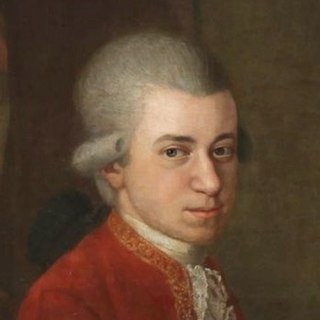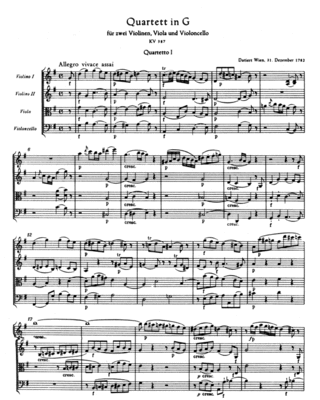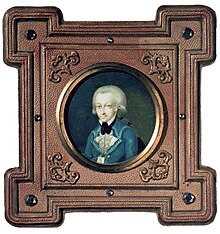The Piano Sonata No. 16 in C major, K. 545, by Wolfgang Amadeus Mozart was described by Mozart in his own thematic catalogue as "for beginners", and it is very commonly known by the nickname Sonata facile or Sonata semplice. Despite this, the sonata is actually not an easy work to perform and can hardly be described as "for beginners."
Symphony No. 39 is a symphony in G minor by Franz Joseph Haydn in 1765, at the age of 33 under the beneficence of Prince Nikolaus Esterházy. It is the earliest of Haydn's minor key symphonies associated with his Sturm und Drang period works.

Wolfgang Amadeus Mozart completed his Symphony No. 41 in C major, K. 551, on 10 August 1788. The longest and last symphony that he composed, it is regarded by many critics as among the greatest symphonies in classical music. The work is nicknamed the Jupiter Symphony, probably coined by the impresario Johann Peter Salomon.

Symphony No. 40 in G minor, K. 550 was written by Wolfgang Amadeus Mozart in 1788. It is sometimes referred to as the "Great G minor symphony", to distinguish it from the "Little G minor symphony", No. 25. The two are the only extant minor key symphonies Mozart wrote.

The Symphony No. 36 in C major, K. 425, also known as the Linz Symphony, was written by Wolfgang Amadeus Mozart during a stopover in the Austrian town of Linz on his and his wife's way back home to Vienna from Salzburg in late 1783. The entire symphony was written in four days to accommodate the local count's announcement, upon hearing of the Mozarts' arrival in Linz, of a concert. The première in Linz took place on 4 November 1783. The composition was also premièred in Vienna on 1 April 1784. The autograph score of the "Linz Symphony" was not preserved, but a set of parts sold by Mozart to the Fürstenberg court at Donaueschingen in 1786 does survive.

Ludwig van Beethoven's Symphony No. 1 in C major, Op. 21, was dedicated to Baron Gottfried van Swieten, an early patron of the composer. The piece was published in 1801 by Hoffmeister & Kühnel of Leipzig. It is not known exactly when Beethoven finished writing this work, but sketches of the finale were found to be from 1795.

Symphony No. 35 in D major, K. 385, also known as the Haffner Symphony, was composed by Wolfgang Amadeus Mozart in 1782. It was commissioned by the Haffners, a prominent Salzburg family, for the occasion of the ennoblement of Sigmund Haffner the Younger. The Haffner Symphony should not be confused with the eight-movement Haffner Serenade, another piece Mozart wrote on commission from the same family in 1776.

The Violin Concerto No. 3 in G major, K. 216, was composed by Wolfgang Amadeus Mozart in Salzburg in 1775 when he was 19 years old. In a letter to his father, Mozart called it the "Straßburg-Concert". Researchers believe this epithet comes from the motive in the third movement's Allegretto in the central section, a local dance that already had appeared as a musette-imitating tune in a symphony by Carl Ditters von Dittersdorf.

The String Quartet No. 14 in G major, K. 387, nicknamed the "Spring" quartet, was composed by Wolfgang Amadeus Mozart in 1782 while in Vienna. In the composer's inscription on the title page of the autograph score is stated: "li 31 di decembre 1782 in vienna". The work was perhaps edited in 1783. This is the first of the Haydn Quartets, a set of six string quartets he wrote during his first few years in Vienna and dedicated to Joseph Haydn.

Symphony No. 14 in A major, K. 114, is a symphony composed by Wolfgang Amadeus Mozart on December 30, 1771, when Mozart was fifteen years old, and a fortnight after the death of the Archbishop Sigismund von Schrattenbach. The piece was written in Salzburg between the composer's second and third trips to Italy. Mozart was also influenced by J. C. Bach's "Italianate" style of composition".

The Symphony No. 52 in C minor is one of the last Sturm und Drang symphonies composed by the Austrian composer Joseph Haydn while the composer was in residence at Esterházy in 1771 or 1772.
The Symphony No. 25 in G major, Perger 16, Sherman 25, MH 334 is a classical symphony that was composed by Michael Haydn in 1783, with a completion date of May 23. It is scored for flute, 2 oboes, 2 bassoons, 2 horns and strings.
Michael Haydn's Symphony No. 39 in C major, Perger 31, Sherman 39, MH 478, written in Salzburg in 1788, is the last C major symphony he wrote, the sixth of his final set of six symphonies.

Symphony No. 1 in C minor, Op. 11, is a work by Felix Mendelssohn, completed on 31 March 1824, when the composer was only 15 years old. The autograph score was published in 1831.

Symphony No. 11 in D major, K. 84/73q, was at one time considered unquestionably to be the work of Wolfgang Amadeus Mozart. Its status has, however, been challenged, and remains uncertain. It is believed to date from 1770, and may have been written in Milan or Bologna, if it is a genuine Mozart work. An early manuscript from Vienna attributes the work to Wolfgang, but nineteenth-century copies of the score attribute it respectively to Leopold Mozart and to Carl Dittersdorf. Neal Zaslaw writes: "A comparison of the results of two stylistic analyses of the work's first movement with analyses of unquestionably genuine first movements of the period by the three composers suggests that Wolfgang is the most likely of the three to have been the composer of K73q".

Symphony No. 17 in G major, K. 129, is the second of three symphonies completed by Wolfgang Amadeus Mozart in May 1772, when he was 16 years old, but some of its sections may have been written earlier.
The six string quartets, K. 168–173, were composed by Wolfgang Amadeus Mozart in late 1773 in Vienna. These are popularly known as the Viennese Quartets. Mozart may have hoped to have them published at the time, but they were published only posthumously by Johann André in 1801 as Mozart's Op. 94.
Felix Mendelssohn wrote thirteen string symphonies between 1821 and 1823, when he was between 12 and 14 years old.. These symphonies were tributes to Classical symphonies especially by Joseph Haydn, Carl Philipp Emanuel Bach, and Wolfgang Amadeus Mozart.

The 50 Greatest Pieces of Classical Music is a compilation of classical works recorded by the London Philharmonic Orchestra with conductor David Parry. Recorded at Abbey Road Studios, Royal Festival Hall and Henry Wood Hall in London, the compilation was released in digital formats in November, 2009 and as a 4-CD set in 2011. The 50 Greatest Pieces of Classical Music has sold over 200,000 copies and spent over three days as one of the top 10 classical albums on iTunes.

G minor has been considered the key through which Wolfgang Amadeus Mozart best expressed sadness and tragedy, and many of his minor key works are in G minor. Though Mozart touched on various minor keys in his symphonies, G minor is the only minor key he used as a main key for his numbered symphonies.















